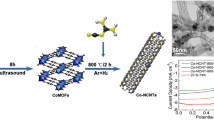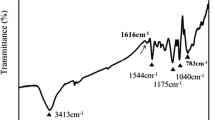Abstract
Oxygen electroreduction is the key reaction among processes and devices of practical importance. Accordingly, the efforts of researchers are directed to the development of catalysts for the oxygen reduction reaction, which provided the effective oxygen reduction and stability at their low cost. Carbon nanotubes modified with oxygen- and nitrogen-containing groups, under the oxygen/nitrogen ratio of 1.3, meet these requirements considerably. In this work, we show that carbon nanotubes modified by oxygen and nitrogen accelerate the oxygen reduction reaction both in acid and alkaline electrolytes. Here, the modifying of carbon nanotubes’ surface increased the electrochemical activity in the oxygen reduction reaction significantly which manifests itself in the shift of the half-wave potential in polarization curves in acid electrolyte by ~0.40 V to more positive values in comparison with not modified carbon nanotubes (in acid electrolyte). In alkaline electrolyte, the modified carbon nanotubes approach monoplatinum catalyst in their activity in the oxygen reduction reaction. The stability of modified carbon nanotubes (according to the testing by the potential cycling) is superior to that of the untreated carbon nanotubes. The obtained data show the perspectives of the modified carbon nanotubes’ application as supports for cathodic catalysts of low-temperature hydrogen–air fuel cells. In the direct alkaline alcohol–air fuel cells and metal–air power sources of lithium–air type, the modified carbon nanotubes can be used as catalysts per se. The tailor-made synthesis of desired type and amount of nitrogen-containing groups is suggested to be realizable after the preliminary modification of carbon nanotubes with the oxygen-containing groups.







Similar content being viewed by others
REFERENCES
Brzhezinskaya, M.M., Baitinger, E.M., Belenkov, E.A., and Svirskaya, L.M., Defect electron states in carbon nanotubes and graphite from the NEXAFS spectroscopy data, Physics Solid State, 2013, vol. 55, no. 4, p. 779.
Dang Sheng Su, Perathoner, S., and Centi, G., Nanocarbons for Development of Advanced Catalysts, Chem. Rev., 2013, vol. 113, no. 8, p. 5782.
Dang Sheng Su, Guodong Wen, Shuchang Wu, Feng Peng, and Robert Schlçgl, Carbocatalysis in Liquid-Phase Reactions, Angew. Chem. Int. Ed., 2017, vol. 56, p. 936.
Sharma, S., Groves, M.N., Fennell, J., Soin, N., Horswell, S.L., and Malardier-Jugroot, C., Carboxyl group enhanced CO tolerant GO supported Pt catalysts: DFT and electrochemical analysis., Chem. Mater., 2014, vol. 26(21), p. 6142.
Bogdanovskaya, V.A., Tarasevich, M.R., Radina, M.V., Zhutaeva, G.V., Kuzov, A.V., Kol’tsova, E.M., and Gavrilova, N.N., Highly active and stable catalysts based on nanotubes and modified platinum for fuel cells, Russ. J. Electrochem., 2016, vol. 52, no. 8, p. 723.
Maiorova, N.A., Tuseeva, E.K., Sosenkin, V.E., Richagov, A.Yu., Vol’fkovich, Yu.M.,Krestinin, A.V., Zvereva, G.I., Zhigalina, O.M., and Khazova, O.A., Influence of CNT functionalization on the structure and catalytical properties of electrodeposition catalysts, Russ. J. Electrochem., 2009, vol. 45, p. 1108.
Lei Qin, Wei Lv, Wei Wei, Feiyu Kang, Dengyun Zhai, and Quan-Hong Yang. Oxygen-enriched CNTs as a bifunctional catalyst promote the oxygen reduction/evolution reactions in Li–O2 batteries, Carbon, 2019, vol.141, p. 561.
Sang, Y., Fu, A., Li, H., Zhang, J., Li, Z., Li, H., Zhao, X.S., and Guo, P., Experimental and theoretical studies on the effect of functional groups on carbon nanotubes to its oxygen reduction reaction activity, Colloids Surfaces A: Physicochem. Eng. Aspects., 2016, vol. 506, p. 476.
Likodimos, V., Steriotis, T.A., Papageorgiou, S.K., Romanos, G.Em., Marques, R.R.N., Rocha, R.P., Faria, J.L., Pereira, M.F.R., Figueiredo, J.L., Silva, A.M.T., and Falaras, P., Controlled surface functionalization of multiwall carbon nanotubes by HNO3 hydrothermal oxidation, Carbon, 2014, vol. 69, p. 311.
Moraitis, G., Špitalský, Z., Ravani, F., Siokou, A., and Galiotis, C. Electrochemical oxidation of multi-wall carbon nanotubes, Carbon, 2011, vol. 49, no. 8, p. 2702.
Nanocarbon for Advanced Energy Conversion, Xinliang Feng, Ed., 2015, Wiley–VCH.
Maiyalagan, T., Maheswari, S., and Saji, V.S., Heteroatom-doped Nanostructured Carbon Materials as ORR Electrocatalysts for Low-temperature Fuel Cells.Ch.13, In: Electrocatalysis for Low Temperature Fuel Cells: Fundamentals and Recent Trends, Maiyalagan, T. and Saji, V.S., Eds., 2017, p. 401.
Rocha, R.P., Soares, O., Goncalves, A.G., Pereira, M., and Figueiredo, J.L. Different methodologies for synthesis of nitrogen doped carbon nanotubes and their use in catalytic wet air oxidation, Appl. Catal. A: General., 2017, vol. 548, no. 25, p. 62.
Ratso, S., Kruusenberg, I., Joost, U., Saar, R., and Tammeveski, K., Enhanced oxygen reduction reaction activity of nitrogen-doped graphene/multi-walled carbon nanotube catalysts in alkaline media, Int. J. Hydrog. Energy, 2016, p. 1.
Wei, Q., Tong, X., Zhang, G., Qiao, J., Gong, Q., and Sun, S., Nitrogen-Doped Carbon Nanotube and Graphene Materials for Oxygen Reduction Reaction, Catalysts, 2015, vol. 5,3, p. 1574.
Arrigo, R., Hävecker, M., Wrabetz, S., Blume, R., Lerch, M., McGregor, J., Parrott, E.P.J., Zeitler, J.A., Gladden, L.F., Knop-Gericke, A., Schlögl, R., and Su, D.S., Tuning the Acid/Base Properties of Nanocarbons by Functionalization via Amination, J. Am.Chem. Soc., 2010, vol. 132, p. 9616.
Wepasnick, K.A., Smith, B.A., Bitter, J.L., and Fairbrother, D.H., Chemical and structural characterization of carbon nanotube surfaces, Anal. Bioanal. Chem., 2010, vol. 396, no. 3, p. 1003.
Lin, He, Weniger, F., Neumann, H., and Beller, M., Synthesis, Characterization, and Application of Metal Nanoparticles Supported on Nitrogen-Doped Carbon Catalysis, Angew. Chem., 2016, https://doi.org/10.1002/anie.201603198
Huang, Z., Liao, Z., Yang, W., Zhou, H., Fu, C., Gonga, Y., Chen, L., and Kuang, Y., Different types of nitrogen species in nitrogen-doped carbon material: The formation mechanism and catalytic role on oxygen reduction reaction, Electrochim. Acta, 2017, vol. 245, p. 957.
Huang, S.F., Terakura, K., Ozaki, T., Ikeda, T., Boero, M., Oshima, M., and Ozaki, J., Miyata, S., First-principles calculation of the electronic properties of graphene clusters doped with nitrogen and boron: Analysis of catalytic activity for the oxygen reduction reaction, Phys. Rev. B., 2009, vol. 80, no. 23, p. 1.
Arkhipova, E.A., Ivanov, A.S., Strokova, N.E., Chernyak, S.A., Shumyantsev, A.V., Maslakov, K.I., Savilov, S.V., and Lunin, V.V., Structural evolution of nitrogen-doped carbon nanotubes: From synthesis and oxidation to thermal defunctionalization, Carbon, 2017, vol. 125, p. 20.
Guo, D., Shibuya, R., Akiba, C., Saji, S., Kondo, T., and Nakamura, J., Active sites of nitrogen-doped carbon materials for oxygen reduction reaction clarified using model catalysts, Science, 2016, vol. 351(6271), p. 361.
Liu, Yang, Zhuang, Cai, Liang, Hao, Lingling, Ran, Xin, Xu, Ying, Dai, Siyu, Pan, Baojian, and Jing, Jinlong, Zou, Increase of structural defects by N doping in MoS2 cross-linked with N-doped CNTs/carbon for enhancing charge transfer in oxygen reduction, Electrochim. Acta, 2018, vol. 283, p. 448.
Qing, Lv, Wenyan, Si, Jianjiang, He, Lei, Sun, Chunfang, Zhang, Ning, Wang, Ze, Yang, Xiaodong, Li, Xin, Wang, Weiqiao, Deng, Yunze, Long, Changshui, Huang, and Yuliang, Li., Selectively nitrogen-doped carbon materials as superior metal-free catalysts for oxygen reduction. Nature Commun., 2018, vol. 9. Article number: 3376.
Inagaki, M., Toyoda, M., Soneda, Y., and Morishita, T., Nitrogen-doped carbon materials. Carbon, 2018, vol.132, p.104.
Wepasnick, K.A., Smith, B.A., Schrote, K.E., Wilson, H.K., Diegelmann, S.R., and Fairbrother, D.H., Surface and structural characterization of multi-walled carbon nanotubes following different oxidative treatments, Carbon., 2011, vol. 49, p. 24.
Rocha, R.P., Soares, O.S.G.P., Goncalves, A.G., Orfao, J.J.M., Pereira, M.F.R., and Figueiredo, J.L., Different methodologies for synthesis of nitrogen doped carbon nanotubes and their use in catalytic wet air oxidation, Appl. Catalysis A: General, 2017, vol. 548, p. 62.
Soares, O.S.G.P., Rocha, R.P., Goncalves, A.G., Figueiredo, J.L., Orfao, J.J.M., and Pereira, M.F.R., Easy method to prepare N-doped CNTsby ball milling., Carbon, 2015, vol. 91, p. 114.
Bogdanovskaya, V.A., Krasilnikova, O.K., Kuzov, A.V., Radina, M.V., Tarasevich, M.R., Avakov, V.B., Kapustin, A.V., and Landgraf, I.K., Electrochemical and structure characteristics of PtCoCr/C—catalyst with platinum content 50 wt % and cathode on its basis for fuel cell with proton-conducting polymer electrolyte, Russ. J. Electrochem., 2015, vol. 51, p. 602
Shirley, D.A., High-Resolution X-Ray Photoemission Spectrum of the Valence Bands of Gold, Phys. Rev., 1972, vol. 5, p. 4709.
Scofield, H., Hartree–Slater subshell photoionization cross-sections at 1254 and 1487 eV, J. Electron Spectrosc. Relat. Phenom., 1976, vol. 8, p. 129.
Oschatz, M. and Walczak, R., Crucial Factors for the Application of Functional Nanoporous Carbon-Based Materials in Energy and Environmental Applications, J. Carbon Research, 2018, vol. 4, p. 56.
Datsyuk, V., Kalyva, M., Papagelis, K., Parthenios, J., Tasis, D., Siokou, A., Kallitsis, I., and Galiotis, C., Chemical oxidation of multiwalled carbon nanotubes, Carbon, 2008, vol. 46, p. 833.
Cheng-Meng Chen, Qiang Zhang, Xiao-Chen Zhao, Bingsen Zhang, Qing-Qiang Kong, Mang-Guo Yang, Quan-Hong Yang, Mao-Zhang Wang, Yong-Gang Yang, Robert Schlogl, and Dang Sheng Su., Hierarchically aminated graphene honeycombs for electrochemical capacitive energy storage, J. Mater. Chem., 2012, vol. 22, p. 14076.
Heejin Kim, Kirak Lee, Seong Ihl Woo, and Yousung Jung, On the mechanism of enhanced oxygen reduction reaction in nitrogen-doped graphene nanoribbons, Phys.Chem.Chem.Phys. 2011, vol. 39, no. 13, p. 17505.
Unni, S.M., Bhange, S.N., Illathvalappil, R., Mutneja, N., Patil, K.R., and Kurungot, S., Nitrogen induced surface area and conductivity modulation of carbon nanohorn and its function as an efficient metal-free oxygen reduction electrocatalyst for anion-exchange membrane fuel cells, Small, 2015, vol. 11, no. 3, p. 352.
Yuyan Shao, Sheng Zhang, Mark H. Engelhard, Guosheng Li, Guocheng Shao, Yong Wang, Jun Liu, Ilhan A. Aksay, and Yuehe Lin, Nitrogen-doped graphene and its electrochemical applications. J. Mater. Chem., 2010, vol. 20, p. 7491.
Esrafili, M.D. and Saeid, N., A catalyst-free achieving of N-doped carbon nanotubes: The healing of single-vacancy defects by NO molecule, Chem. Phys. Lett., 2018, vol. 691, p. 172.
Gui-Li Tian, Qiang Zhang, Bingsen Zhang, Yu-Guang Jin, Jia-Qi Huang, Dang Sheng Su, and Fei Wei, Toward Full Exposure of “Active Sites”: Nanocarbon Electrocatalyst with Surface Enriched Nitrogen for Superior Oxygen Reduction and Evolution Reactivity, Adv. Funct. Mater., 2014, vol. 24, p. 5956.
Gongxiu Guo, Xili Tong, and Xiangyun Guo, Nitrogen-doped mesoporous network-like carbon as an efficient metal-free electrocatalyst for oxygen reduction reaction, Int. J. Hydrogen Energy, 2016, vol. 41, p. 48.
Ratso, S., Kruusenberg, I., Joost, U., Saar, R., and Tammeveski, K., Enhanced oxygen reduction reaction activity of nitrogen-doped graphene/multi-walled carbon nanotube catalysts in alkaline media, Int. J. Hydrog. Energy, 2016, p. 1.
Tarasevich, M.R. and Korchagin, O.V., Electrocatalysis and pH, Russ. J. Electrochem., 2013, vol. 49, p. 608.
Chi-Yeong Ahn, Wonchan Hwang, Hyunjoon Lee, Sungjun Kim, Ji Eun Park, Ok-Hee Kim, Min Her, Yong-Hun Cho, and Yung-Eun Sung, Effect of N‑doped carbon coatings on the durability of highly loaded platinum and alloy catalysts with different carbon supports for polymer electrolyte membrane fuel cells, Int. J. Hydrogen Energy, 2018, vol. 43, p. 1007.
Stamatin, S.N., Borghei, M., Dhiman, R., Andersena, S.M., Ruiz, V., Kauppinen, E., and Skou, E.M., Activity and stability studies of platinized multi-walled CNTs as fuel cell electrocatalysts, Appl. Catal. B: Environmental, 2015, vol. 162, p. 289.
Funding
This work has financial support from the Ministry of Science and Higher Education RF.
Author information
Authors and Affiliations
Corresponding author
Ethics declarations
The authors declare that they have no conflict of interest.
Additional information
Translated by Yu. Pleskov
In memory of the famous electrochemist Vladimir Sergeevich Bagotzky whose centenary is celebrated in 2020.
Rights and permissions
About this article
Cite this article
Bogdanovskaya, V.A., Radina, M.V., Korchagin, O.V. et al. Carbon Nanotubes Modified with Oxygen- and Nitrogen-Containing Groups as Perspective Catalysts for the Oxygen Electroreduction Reaction. Russ J Electrochem 56, 809–820 (2020). https://doi.org/10.1134/S1023193520100043
Received:
Revised:
Accepted:
Published:
Issue Date:
DOI: https://doi.org/10.1134/S1023193520100043




